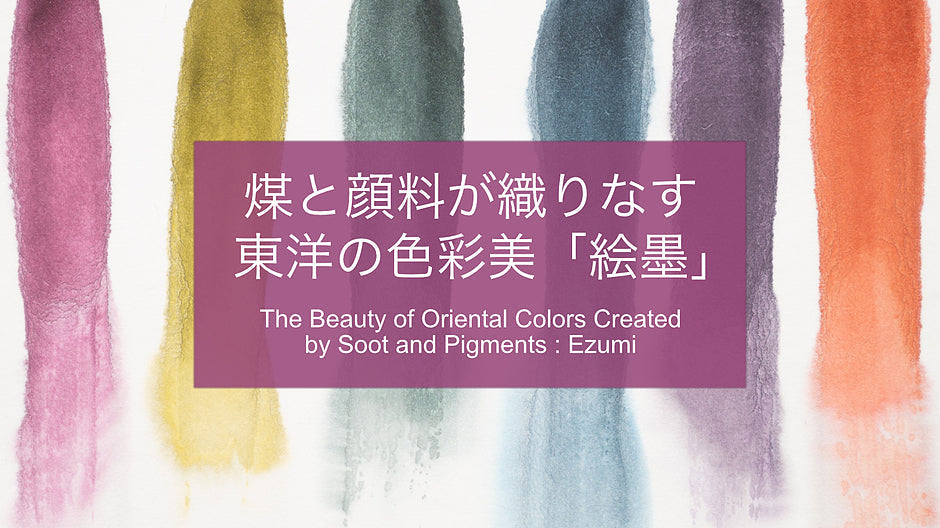Sumi inksticks are essential to East Asian arts such as Suibokuga (ink wash painting) and Nihonga (Japanese painting that uses animal glue). The beauty of ground Sumi ink is how it bleeds and blurs on paper, and these types of expressions are made possible because of the production of black soot by burning oil or pine.
Since its particles are extremely fine compared to the usual pigments, we can create beautiful tones and shades unique to Sumi ink. People who have grown up in Japan might have experienced getting Sumi ink on their clothes in a calligraphy class and couldn’t remove it anymore even after washing it. One of the main reasons for this to happen is because of its fine particles.
Of course, there are many other fascinating aspects of Sumi inksticks that are not widely known, but it is very important to point out that soot is what creates the beautiful deep monotone of Sumi inksticks.
In general, the Sumi inksticks require grinding on an inkstone, however, with this product named “Ezumi” (colored Sumi ink), you can enjoy the same color expressions of soot more casually.
Most Sumi inksticks are made by kneading soot and animal glue together, and we cannot obtain beautiful ink by just rubbing it with a wet brush. However, if you apply a wet paintbrush to the Ezumi series, the colors will melt out immediately because it is a watercolor paint made of pigment with gum arabic and contains soot.
This product is manufactured by Boku-Undo Company, a long cooperative partner of PIGMENT TOKYO.
Based on the Sumi ink-making techniques cultivated by the Sumi specialist established in 1805, the company has been carefully selecting hue, brightness, saturation and expressiveness to create colors that cannot be reproduced by simply kneading the materials by hand.
Now let's take a look at the actual colors. In this article, I applied them on two kinds of paper, one is made for watercolor painting and the other one is for ink wash painting, both Washi papers are made of bamboo fibers. The first sample is the standard Ezumi series.

【Art Materilas Used 】
Color Material: Ezumi
Substrate: Bamboo Washi for Watercolor

【Art Materilas Used 】
Color Material: Ezumi
Substrate: Bamboo Washi for Suibokuga (Japanese Ink Painting)
These beautiful monotone colors remind me of old black-and-white films. Since they do not contain strong pigments that cover up the underlying layers, they can be diluted with water to create a transparent look.
The fine particles of soot soak into the fibers of the paper, creating a more beautiful gradation than watercolors made with pigments alone and this feature is what makes Ezumi series so unique.
Moreover, different ink-bleeding effects are obtained by changing the substrates even among Washi paper made of bamboo. If you want to show more brush strokes, use watercolor paper; and if you want the ink to be more spread out, use ink painting paper.
Personally, my favorite colors are blue shades. There is a Sumi inkstick called "Soshin '' that is a mixture of soot and indigo made by Boku-undo company, but the Ezumi's blue colors are even more saturated than Soshin.
Fun fact, there are two types of Sumi ink: a bluish ink called Seiboku (青墨) and brownish ink called Chaboku (茶墨).
Then, let’s see the colors of “Ezumi Mei.”

【Art Materilas Used 】
Color Material: Ezumi Mei
Substrate: Bamboo Washi for Watercolor

【Art Materilas Used 】
Color Material: Ezumi Mei
Substrate: Bamboo Washi for Suibokuga (Japanese Ink Painting)
Compared to the previous standard Ezumi series, the colors are more saturated because they contain less soot. You can select them according to your preference, for example, standard Ezumi for monotone drawings and Ezumi Mei for coloring like how Gansai (traditional Japanese watercolor) is used.
The reddish color on the far right is a little more brownish than the vermilion we see.
This color was selected because the color palette of "Ezumi" is unified with subdued colors and there was a discussion that it would be good to have a slightly vivid color in this palette.
Furthermore, layers of colors can be created by this watercolor by adjusting the amount of water.
Let's take a look at some examples.

【Art Materilas Used 】
Color Material: Ezumi
Substrate: Bamboo Washi for Watercolor
Here is a sample made by PIGMENT TOKYO's staff. When we zoom in the grapes, you can see the gradations of colors.

The grapes with circular shapes have black outlines around them.
They appeared because the technique called "Tarashikomi (垂込)" is used here in which the paper is moistened with a large amount of water while painting it. In this way, it is possible to cause the separation of pigment and soot intentionally by simply changing how to use the material.
The product photo alone may look like just a plain black watercolor palette, but when we actually use them, we see that the palette can produce a rich and wide range of colors as shown here.
Next time, when you get to visit us in Tennoz Isle, feel free to ask a staff member to try out these Ezumi palettes!
Translated by Atsumi Okano, Nelson Hor Ee Herng
PIGMENT TOKYO Art Materials Experts




